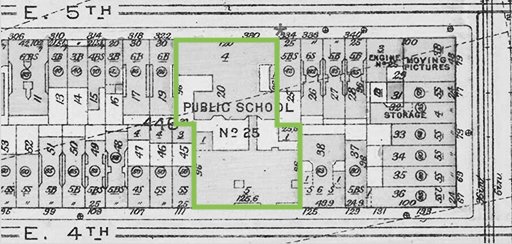A Historic Village Block
E. 5th Street is a historic residential block in Manhattan’s East Village, known for narrow rowhouses, one of two surving Flemish Revival-style schools, and a restored 9th Precinct stationhouse whose original 1912 cast-stone façade was reassembled in 2007.

Only one of the Flemish-style school buildings survives today, which is the Career School (shown on right).

East 5th Street in Manhattan’s East Village is notably narrower than many other streets due to its origins predating the Commissioners’ Plan of 1811, which established the standardized grid system for much of Manhattan. Consequently, East 5th Street and its neighboring streets were laid out with narrower widths, reflecting the urban planning practices of that earlier period.
Recently, in line with commitments made in the SoHo/NoHo Neighborhood Plan, the NYC Department of Housing Preservation and Development (HPD) has assumed control of 324 E. 5th Street to create affordable housing in what is currently a parking lot used by the NYPD.
Residents have expressed concern within the context of massing diagrams that show a potential structure exceeding 100 feet in width and rising 14 stories, significantly out of proportion in a historically narrow, interior-street residential environment of Victorian-style rowhomes.
Unlike nearby comparables—like Greenwich Village—which was landmarked early and carefully preserved, the East Village faces delayed protections in spite of a rich, albeit architecturally inconsistent (according to our own inquiries with the Landmarks Commission), progressive working-class heritage. Ranking among Manhattan’s top neighborhoods for city-led affordable housing, its geometrical 'center' remains municipally unprotected.
5SPC seeks to work with community stakeholders on a balanced solution that pays its support to the City's entrenched need for affordable housing, while guaranteeing the fundamental future success of a historical block.
- "Old New York Schools: A Journey Through History," Chapter 3, pp. 45-46, 2018, and "Architectural Changes in New York City," The New York Times, May 17, 2005, nytimes.com, English.
- "Parks and Recreation in Urban Areas," Chapter 6, pp. 102-103, 2017, and "Transforming Urban Spaces: A History of New York City Parks," Journal of Urban History, Vol. 39, No. 2, pp. 123-125, urbanhistoryjournal.com, English.
- "Gentrification and Its Discontents: The East Village," Chapter 7, pp. 156-158, 2020, and "Sustainable Urban Development: Case Studies," Sustainable Cities Journal, Vol. 18, No. 2, pp. 176-178, sustainablecitiesjournal.com, English.
- Affordable Housing Production by Building | NYC Open Data, https://data.cityofnewyork.us/Housing-Development/Affordable-Housing-Production-by-Building/hg8x-zxpr/about_data
- NYC New Development Market Report - Year End 2024 | Marketproof, https://marketproof.com/reports/nyc-new-development-market-report-year-end-2024